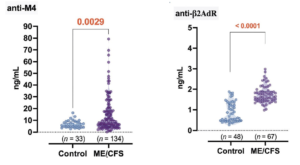Past research has suggested that HHV-6A/B may be one trigger of myalgic encephalomyelitis/chronic fatigue syndrome (ME/CFS), and that these patients also have autoantibodies to G-protein-coupled autonomic receptors. A group from Riga Stradins University looked for these biomarkers in 134 ME/CFS cases diagnosed with the CDC/Fukuda criteria and 33 ethnicity- and age-matched controls (but not gender matched) healthy control subjects.
Using nested PCR with primers against HHV-6 A/B U3 gene, the investigators found a viral load of greater than 1,000 copies/106 in 84.2% of ME/CFS patients with severe clinical course, 72.2% with moderate clinical course, and 57.1% with mild clinical course but in only 11.1% of controls. However, there was no analysis presented of the possible correlation between the actual linear value of the viral load and disease severity.
The investigators looked at levels of autoantibodies against several G-protein-coupled autonomic receptors. As shown in Figure 1, they found significantly higher levels of autoantibodies to the muscarinic receptor M4 (but not muscarinic receptor M3) and against ß2 adrenergic receptor (anti-ß2AdR) in cases of ME/CFS than in healthy controls. However, these levels were not significantly correlated with disease severity. Moreover, no tests were done to determine if these autoantibodies have either agonistic or antagonistic effects on autonomic receptors, effects that could explain some of the symptoms of the illness.

Figure 1. Comparison of the levels of autoantibodies against two autonomic nervous system receptors, M3 and ß2AdR, in cases of ME/CFS vs. healthy control subjects.
The increase in HHV-6 load was correlated with the increase in anti-M4 level, and the increase in anti-M4 level, in turn, was associated with the increase in anti-ß2AdR level. HHV-6 viral load was not correlated with the anti-ß2AdR level, but the study lacked the power required to confidently rule out such a correlation.
This study replicates other studies finding higher levels of HHV-6A/B nucleic acid and of autoantibodies against autonomic nervous system receptors in people with ME/CFS compared to healthy controls subjects. However, questions have recently been raised about the accuracy and value of the assay for autoantibodies, produced by CellTrend GmbH in Luckenwalde, Germany (Hall 2022). Moreover, whether these measurements of viral nucleic acid or autoantibodies serve as useful diagnostic biomarkers depends on whether they distinguish people with ME/CFS from people with other fatiguing illnesses, a question that has not yet been seriously pursued.
And, particularly given the lack of clarity as to whether viral load correlated with disease severity and the question of whether the autoantibodies are functionally active, it remains unclear if they are merely epiphenomena or whether they play a central role in the pathophysiology of ME/CFS.
Read the full article: Gravelsina 2022

